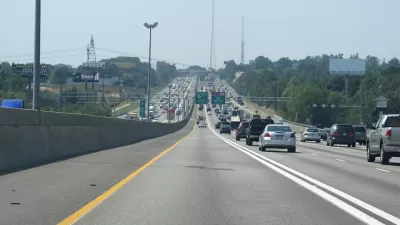Hopes are high that the East River Ferry connecting Queens, Brooklyn, and Manhattan can become a viable commuting mode, while also boosting development around its landings. Although ridership is growing, some doubt if it can become self-sustaining.
While the priceless views and serene surroundings win raves from its few regular riders, only one year into a three-year contract subsidized to the tune of $9 million by the City of New York, "the verdict on whether the service will sustain itself is far from clear," reports Joseph Berger.
"The number of riders on the service as a whole is growing; in its first
year, beginning in June 2011, 1.2 million passengers rode the ferries,
according to the New York City Economic Development Corporation, which
oversees the service." But many of those riders were tourists and families out for a one-time jaunt. "But it is not yet apparent," writes Berger, "that the ferries can become a daily habit for
enough people to keep New York Waterway, which operates the ferry, from
losing money, as it has on some other routes."
FULL STORY: Hoping to Lure Riders With Scenic Commutes

Planetizen Federal Action Tracker
A weekly monitor of how Trump’s orders and actions are impacting planners and planning in America.

Congressman Proposes Bill to Rename DC Metro “Trump Train”
The Make Autorail Great Again Act would withhold federal funding to the system until the Washington Metropolitan Area Transit Authority (WMATA), rebrands as the Washington Metropolitan Authority for Greater Access (WMAGA).

The Simple Legislative Tool Transforming Vacant Downtowns
In California, Michigan and Georgia, an easy win is bringing dollars — and delight — back to city centers.

The States Losing Rural Delivery Rooms at an Alarming Pace
In some states, as few as 9% of rural hospitals still deliver babies. As a result, rising pre-term births, no adequate pre-term care and "harrowing" close calls are a growing reality.

The Small South Asian Republic Going all in on EVs
Thanks to one simple policy change less than five years ago, 65% of new cars in this Himalayan country are now electric.

DC Backpedals on Bike Lane Protection, Swaps Barriers for Paint
Citing aesthetic concerns, the city is removing the concrete barriers and flexposts that once separated Arizona Avenue cyclists from motor vehicles.
Urban Design for Planners 1: Software Tools
This six-course series explores essential urban design concepts using open source software and equips planners with the tools they need to participate fully in the urban design process.
Planning for Universal Design
Learn the tools for implementing Universal Design in planning regulations.
Smith Gee Studio
City of Charlotte
City of Camden Redevelopment Agency
City of Astoria
Transportation Research & Education Center (TREC) at Portland State University
US High Speed Rail Association
City of Camden Redevelopment Agency
Municipality of Princeton (NJ)





























